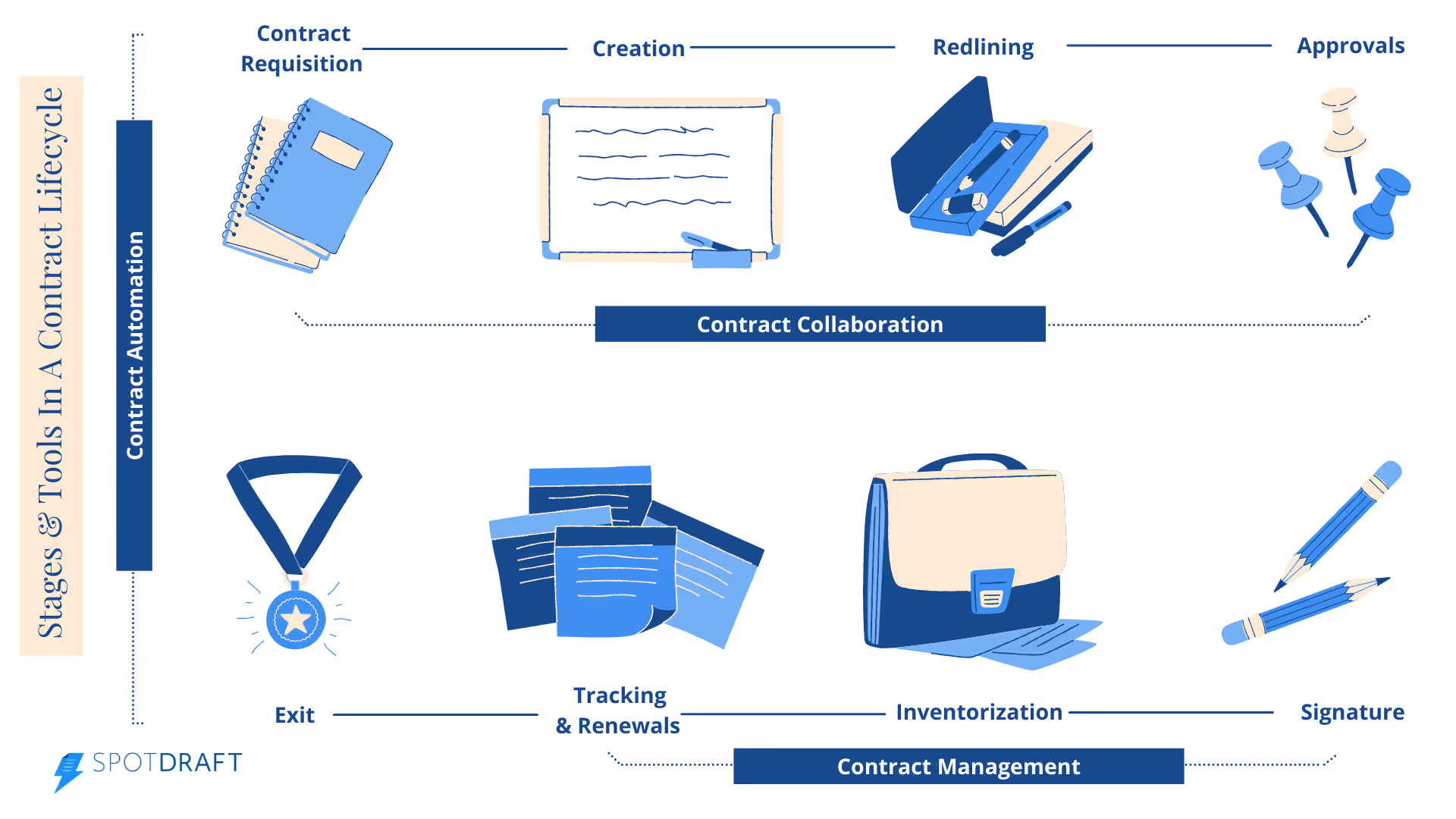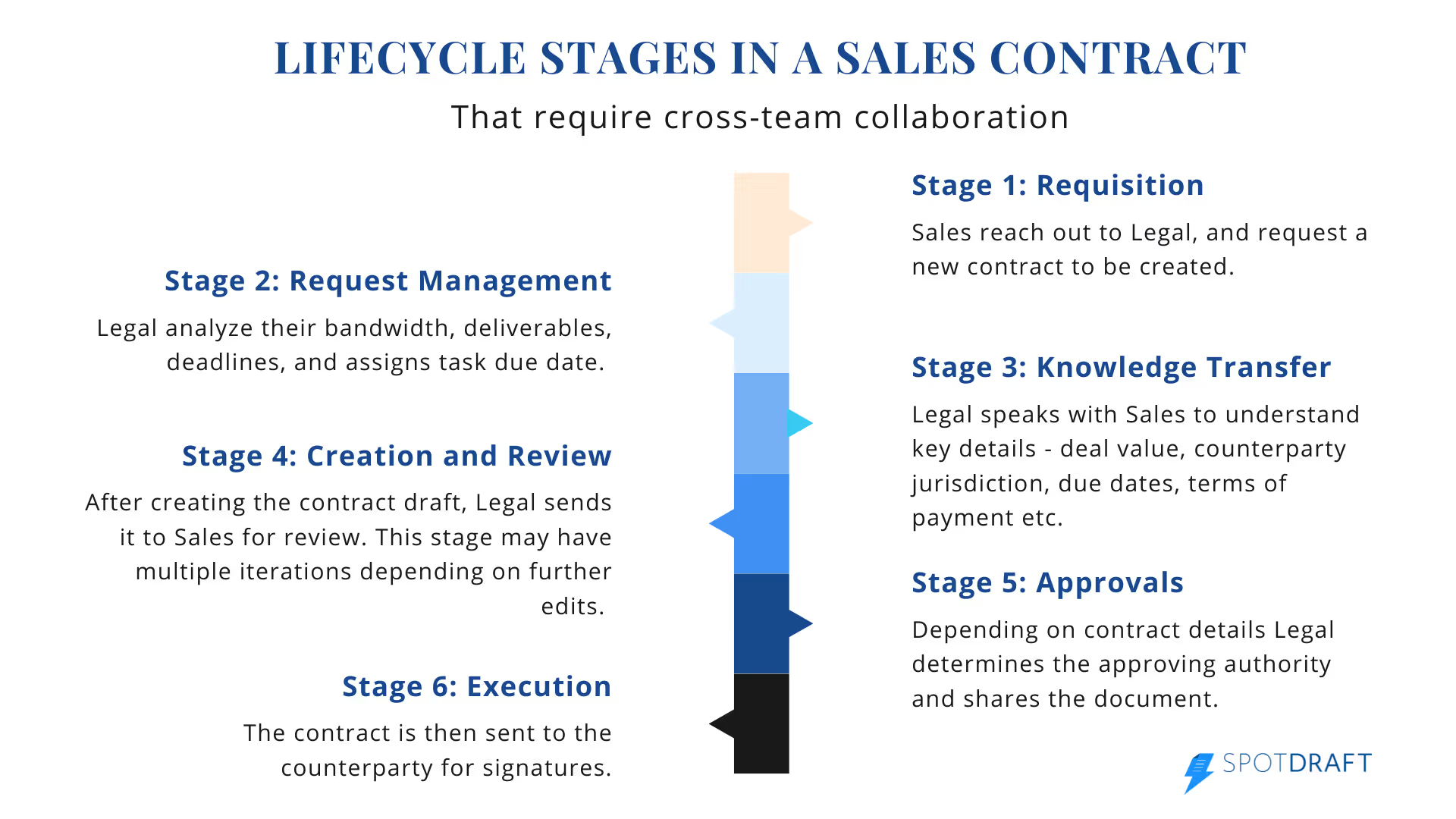While contract ownership rests solely on Legal in most businesses, contracts are still a collaborative function that requires knowledge sharing, reviews, and approvals from many different parties within and even outside the business.
And like any people-driven function, efficiency is a direct function of collaboration. Enter contract collaboration platforms – tools that help unify different teams working on contracts right from initiating a request to negotiating and redlining the document.
With advances in AI contract collaboration and GenAI for contract teams, these platforms are becoming increasingly intelligent and automated.
What is a Contract Collaboration Software?
A contract collaboration platform is a tool that helps automate contract requests, unify conversations on contracts into a single space, helps redline without multiplying versions, and provides deep visibility into every stakeholder's actions on a particular contract.
Modern contract collaboration platforms integrate AI-powered contract review capabilities and connect with your contract library to set contract reminders and automate process renewal or foreclosure requests. Leading solutions now incorporate AI contract collaboration features to streamline legal workflow automation across the entire contract lifecycle.
How is a Contract Collaboration Software different from a contract management platform?
There are many tools in the market that look similar but differ in the stage of the contract lifecycle that they solve. And while the nomenclature is used interchangeably - contract management, contract editing, collaborative contract management, or contract automation have distinct responsibilities from each other. To understand more simply let's break down a typical contract lifecycle and classify where each tool figures in:
To understand more simply let’s break down a typical contract lifecycle and classify where each tool figures in:

What can Contract Collaboration Software do for your Business?
While it is always a good idea to have one platform for all your contracting needs, we will restrict this article to tools that have the ability to simplify all collaborative stages in a contract. The following are the typical stages in a contract lifecycle for Sales contracts, that can be automated or made more accurate by leveraging AI contract collaboration and GenAI for contract teams.

While each contract collaboration platform will be different from the other, there are a few benefits that most provide:
Automated request management
Tracking all contract requests, especially when they are coming in from multiple teams, directions, and via multiple channels can get tricky. With an integrated request dashboard and legal workflow automation, lawyers can keep track of moving projects, and prioritize contracts that are high-impact or of immediate requirement over others.
This also means better workload management and faster turnaround times, a key advantage of modern contract collaboration platforms.
Seamless and centralized knowledge sharing
Speaking of faster TaTs, expecting a lawyer to get back to the internal stakeholder for information at every new instance is a process inefficiency that stretches contract lifecycles.
A contract collaboration platform with contract intelligence capabilities can automate the entire process by pulling in necessary data for Legal to initiate the contract building process.
All of this data is stored in a single repository linked to the requisition dashboard to minimize the time loss in hunting for context. This ensures no lost or missing context, and more importantly – faster, compliant contracts enabled by collaborative contract management systems and GenAI legal assistant technology.
Inclusive contract editing and review
If every new edit instance is forcing a new document version for the same contract - there is eventually a trail of unnecessary documents and continuous back-and-forth between teams. Sharing one version after another via mail or messaging tools can also lead to loss of critical information and force a reboot of the drafting process.
By allowing real-time document edits with an AI redlining tool to track changes made by any stakeholder, contract collaboration platforms can increase accountability, make the editing process more inclusive, and prevent working in silos. Advanced AI co-authoring features allow multiple team members to work simultaneously while maintaining version control.
Note: Many platforms like SpotDraft also allow document integration for 3rd-party edits through 3rd-party contract comparison features. Once a new document version for the same contract is imported, the AI-powered contract review system automatically analyzes changes, unifies them into one document, and highlights all changes made.
This means that there is only one single version for each contract, and zero document byproduct across folders to worry about, another major benefit of a reliable contract collaboration platform with AI contract collaboration capabilities.
Evaluating the Right Contract Collaboration Software
A contract collaboration platform must help make decisions faster, liberate legal departments from process inefficiencies, and make communication smoother. But beyond that, it must also help you follow through and help you meet your organizational needs without kicking up a storm.
Here are 5 quintessential features to look for in a contract collaboration platform:
1. Real-time audit trails
Since contracts are always a high-stakes game, it is necessary that your contract collaboration platform does not forego accountability. Every change made to the contract - irrespective of the editor - needs to be actively monitored, traced, and presented in a unified audit trail. This provides the contract owner the ability to refute unnecessary or erroneous changes and maintain contract security. Modern AI redlining tools make this process even more transparent by automatically flagging significant changes.
2. Custom API integrations
Restructuring your existing processes to fit your new contract collaboration platform is an added time and effort cost. Instead, your platform should seamlessly integrate with your existing business tools and processes through legal workflow automation. Custom API integrations enable a tool to mold itself to suit your style of work instead of forcing you through yet another learning curve.
3. 3rd-party edit analysis
Ever so often a counterparty may try to sneak in an edit or two and try to catch you off guard. It is even harder to track changes to your document when your counterparty sends you a new offline version of your document. Your contract collaboration platform should protect you against such instances with 3rd-party contract comparison capabilities by giving you the ability to import an offline document and then analyze it for changes using AI-powered contract review technology.
4. 3rd-party document review
Your contract collaboration platform should also support you in reviewing and navigating inbound contracts through collaborative contract management features. This helps your team get together and establish if the contract is compliant with your standard or negotiation position before you sign on the paper. While many platforms may focus only on editing, collaborative redlining, and request management – the work of a contract doesn't end there.
Tracking contract renewal dates help your peers initiate renewal discussions faster with contract compliance automation. Advanced contract analytics dashboard features help you gain learnings for future contract issues and aid in the process of solution discovery. A holistic contract collaboration platform should include contract intelligence to provide these insights automatically.
5. Support and technology
This is homogeneous for any contract collaboration platform you are looking for. Customer success and technological flexibility determine how much a tool would mold to your specific requirements, or how fast they can be integrated with all your existing processes.
A GenAI legal assistant embedded within the platform can further accelerate adoption and usage. Readdressing your existing processes to fit a new tool comes with an added time, knowledge, and flexibility cost and can often lead to confusion.
Any long-term implementation therefore must be able to fit snugly to the way you and your peers work, something the best contract collaboration platforms with AI contract collaboration offer as standard.
FAQs around Contract Collaboration
1. How does Contract Collaboration Software improve contract management?
It streamlines collaboration through GenAI for contract teams, automates reviews and approvals with AI redlining tools, and ensures all contract changes are tracked in one place through a contract analytics dashboard, reducing delays and errors.
2. What are the benefits of using Contract Collaboration Software for businesses?
It improves turnaround time through legal workflow automation, enhances visibility across teams with contract intelligence, boosts compliance through contract compliance automation, and reduces the risk of version mismatches or missed obligations with AI co-authoring capabilities.
3. When should a company consider adopting Contract Collaboration Software?
A company should adopt a contract collaboration platform when contracts involve multiple stakeholders, frequent edits, or growing volume that's hard to manage manually. Organizations looking to leverage GenAI legal assistant technology and AI-powered contract review should prioritize platforms with advanced collaborative contract management features and contract compliance automation built-in.


.avif)






